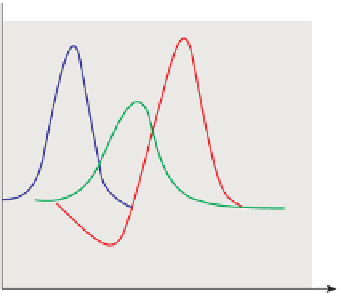Graphics Reference
In-Depth Information
0.4
r
b
l
l
g
l
0.2
0.0
r
l
2
0.2
800
l
400
500
Wavelength,
600
700
l
(nm)
Figure 28.16: The color-matching functions, which indicate, for each wavelength, how
much of a standard red, green, and blue light must be mixed to produce the same sen-
sor responses as a monospectral light of wavelength
λ
. At least one mixing coefficient is
negative for many monospectral lights, indicating the impossibility of making those colors
as mixes of red, green, and blue.
and use these as the amounts of our red, green, and blue primaries. (Of course, if
any of the three computed coefficients is negative, we cannot reproduce the color
with our sources.)
Unfortunately, the set of all convex combinations of our three primaries
doesn't include all possible colors; geometrically, the triangle whose vertices cor-
respond to our primaries is a proper subset of the horseshoe-shaped set of sensor
responses.
In 1931, the CIE defined three standard primaries, which it called
X
,
Y
, and
Z
, with the property that the triangle with these three as vertices actually includes
all possible sensor responses. To do so, the CIE had to create primaries that had
negative
regions in their spectra, that is, they did not correspond to physically
realizable light sources. Nonetheless, these primaries have certain advantages.
•The
Y
primary was defined so that its color-matching function was exactly
the luminous efficiency curve; this means that for any spectral light source,
T
, written as a combination
T
=
c
x
X
+
c
y
Y
+
c
z
Z
,
(28.16)
the number
c
y
will be the perceived intensity of the light. This was signifi-
cant in developing black-and-white televisions: The signal had to transmit
in some form the
Y
-component of the lights that the camera was seeing.
2
Later, when color signals began to be broadcast, the
c
x
and
c
z
data were
sent in a different band; color televisions could decode these, and black-
and-white televisions could ignore them.
• The color-matching functions for
X
,
Y
, and
Z
are everywhere non-negative
(see Figure 28.17), so all colors are expressed as non-negative linear com-
binations of the primaries.
2. The value
c
y
itself is not what's transmitted; more on this later.



























